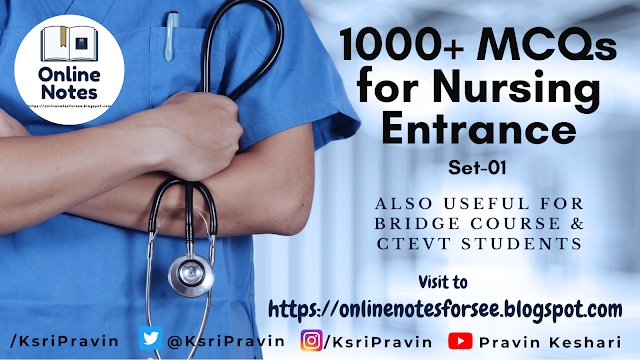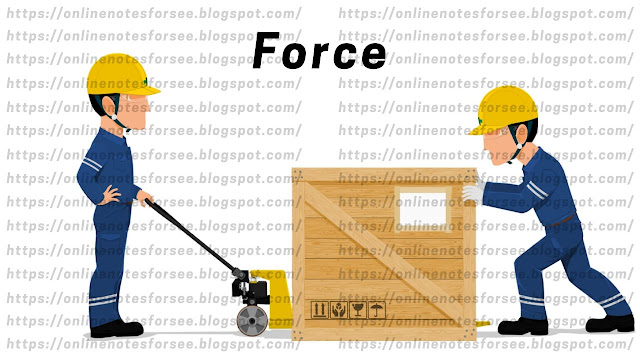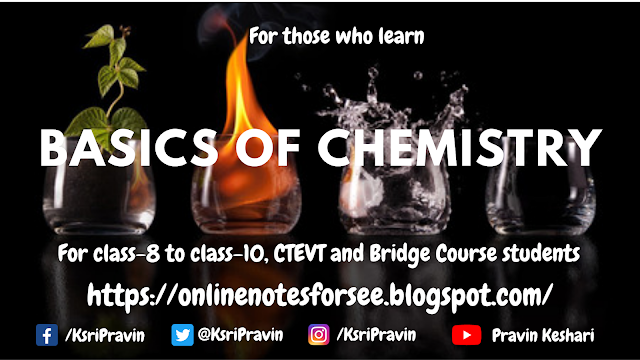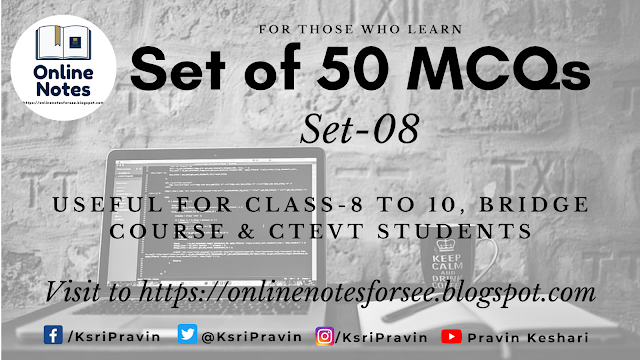1000+ MCQs for PCL Nursing Entrance Preparation || Part-01 ||
1000+ MCQs for PCL Nursing Entrance Preparation
Part-1
With the changing needs as well as Nepal, Government's health policy, CTEVT took an action to respond to these needs; as a result CTEVT has started the PCL Nursing course. PCL Nursing is one of the prominent and popular disciplines within the Nursing profession.
PCL Nursing has its full form of Proficiency Certificate Level in Nursing.

In this particular series of "PCL Nursing Entrance Preparation", each set will contain 50 MCQs (with Answer key) for students to solve. About 1000 MCQs will be provided related with the entrance preparation for PCL Nursing or Staff Nurse. Notes will also be posted, if required.
If you find this blog useful after reading, do not forget to share it with your friends. Refer to your friends, so that they can also enjoy these questions.
Need full PDF syllabus of PCL Nursing???
Click on the icon below to download the full syllabus in PDF

Your MCQs for PCL Nursing starts from here:
1) The branch of science which deals about structure and function of human body is called.....
a) Anatomy
b) Physiology
c) Anatomy & physiology
d) Pathology
2) The outermost layer of skin is made of.....
a) Columnar epithelium
b) Stratified squamous
c) Transitional epithelium
d) Cuboidal squamous
3) The fibrous tissues that cover the bone is called....
a) Perimetrium
b) Pericardium
c) Perichondrium
d) Periosteum
4) Total number of facial bones are.....
a) 14
b) 22
c) 33
d) 60
5) "Patella" is.....
a) Shoot bone
b) Irregular bone
c) Sesamoid bone
d) Flat bone
6) There are........ bones found in Appendicular skeleton?
a) 136
b) 126
c) 146
d) 116
7) Which is not of axial skeleton?
a) Tibia
b) Humerus
c) Pisiform
d) Sternum
8) What is the main function of air sinuses?
a) To lighten the skull
b) To give resonance of voice
c) To pour waste matter of sinus into nasal cavity
d) All of the above
9) To draw CSF, Lu,ber puncture (LP) is done at.....
a) L₁ to L₂
b) L₂ to L₃
c) L₃ to L₄
d) L₄ to L₅
10) Anterior fontanel is ossified at.....
a) 18 months
b) 2-3 months
c) 30 years
d) 2 years
11) Which is the smallest bone in our body?
a) Malleus
b) Carpel
c) Stapes
d) Atlas
12) The tendon connects between.....
a) Muscle to bone
b) Muscle to muscle
c) Bone to bone
d) None
13) The end of long bones are covered by....
a) Ligament
b) Tendon
c) Cartilage
d) Bone cap
14) Odnotoid process is characteristics of.....
a) Atlas
b) Coccyx
c) Thoracic vertebra
d) Axis
15) Which of the following metals can be used in joint related conditions?
a) Mercury
b) Iron
c) Gold
d) Silver
16) Long bones are developed from.....
a) Membrane
b) Cartilage
c) Tendon
d) All
17) Lunate bone forms the part of....
a) Ankle joint
b) Wrist joint
c) Knee joint
d) Shoulder joint
18) Navicular bone is related to.....
a) Tarsal
b) Carpals
c) Tibia
d) Skull
19) Which cartilage is responsible for inter-vertebral disc?
a) Elastic cartilage
b) Hyaline cartilage
c) Calcified cartilage
d) Fibrous cartilage
20) How many bones make thoracic cage?
a) 25
b) 12
c) 37
d) 24
21) What percentage of water is found in bone?/
a) 10%
b) 15%
c) 40%
d) 20%
22) Freely movable joints are covered by.....
a) Mucous membrane
b) Serous membrane
c) Synovial membrane
d) All
23) Harvesian canal is found in.....
a) Bone
b) Brain
c) Pancreas
d) Liver
24) Which is the common muscle for giving intra-muscular?
a) Quadriceps
b) Deltoid
c) Gluteal
d) All
25) Muscle fatigue is due to......
a) Lactic acid
b) Pyrubic acid
c) Oxalo-acetic acid
d) Ketone bodies
26) Which of the following muscle pulls angle of jaw downwards to surprise of horror?
a) Platysma
b) Tiapegius
c) Buccinator
d) Masseter
27) The attractive bulk of calf of female is formed by......muscle.
a) Hamstring
b) Gluteal
c) Gastroenemius
d) Rectus femoris
28) Actin, Myosin and Tropomyosin are the part of.....
a) Cartilage
b) Skeletal muscle
c) Neurone
d) Nephrone
29) What percentage of oxygen is found in expired air?
a) 10%
b) 12%
c) 16%
d) 21%
30) How many lobes does the right lungs posses?
a) 2
b) 3
c) 4
d) 5
31) Trachea is made up of.....'C' shaped hyaline cartilage?
a) 16 to 21
b) 10 to 14
c) 7 to 10
d) 8 to 10
32) The space between two lungs where the heart is situated is called.....
a) Hypophyseal fosa
b) Hilus
c) Sinusoid
d) Mediastenum
33) The capacity of air that can be forcibly expired after the deepest possible inspiration is called....
a) Vital capacity
b) Tidal volume
c) Expiratory reserve volume
d) Residual volume
34) Which is the tidal volume of air in an adult for quite and normal breathing?
a) 300 ml
b) 500 ml
c) 750 ml
d) 1000 ml
35) Alveoli are lined internally by....
a) Columnar epithelium
b) Ciliated epithelium
c) Pavement epithelium
d) Cuboidal epithelium
36) The most powerful buffer system in body is....
a) Protein buffer system
c) Phosphate buffer system
c) Bicarbonate buffer system
d) None
37) There are 12 pairs of ribs among which 1st seven pairs are called...
a) False ribs
b) Vertebrosternal ribs
c) Floating ribs
d) Vertebrochondrial ribs
38) The largest and first developed para-nasal sinus are....
a) Sphenoid sinus
b) Ethmoid sinus
c) Maxillary sinus
d) Frontal sinus
39) The normal pressure within the plural cavity is....
a) Positive
b) Negative
c) Zero
d) None of the above
40) During normal respiration, the amount of oxygen absorbed per minute is....
a) 1000 ml
b) 750 ml
c) 500 ml
d) 250 ml
41) The presence of air in the plural space is known as.........
a) Pneumothorax
b) Pleural effusion
c) Haemothorax
d) Pyothorax
42) Do you know how much oxygen is carried by 1 gm of haemoglobin in the blood?
a) 0.5 ml
b) 1 ml
c) 1.34 ml
d) 2.35 ml
43) Which is not a main function of circulatory system?
a) To transport nutrients in different tissue of the body
b) To provide defense mechanism
c) To maintain acid-base balance
d) To regulate temperature
44) The condition in which the number of WBCs decreased very low is......
a) Leucopenia
b) Thrombopenia
c) Lymphocytosis
d) Leucocytosis
45) What is the name of artery that supply the heart itself?
a) Cardiac artery
b) Coronary artery
c) Pulmonary artery
d) Brachial artery
46) The enlargement of heart by any pathological condition is called....
a) Pericarditis
b) Cardiomyopathy
c) Myocardial intraction
d) Cardiomeghaly
47) The only one artery that carries impure blood in our body is...
a) Renal artery
b) Carotid artery
c) Pulmonary artery
d) Tibial artery
48) The amount of blood that comes out from heart at one time is called....
a) Stroke volume
b) Cardiac output
c) Cardiac cycle
d) Heart rate
49) How much blood does normal healthy adult of average weight have?
a) 3 to 4 liter
b) 4 to 5 liter
c) 5 to 6 liter
d) 7 to 10 liter
50) If temperature is increased by 1⁰ F, he pulse rate is increased by....
a) 8
b) 10
c) 12
d) 15

If you found this post about PCL Nursing useful then do not forget to share it with your friends. Refer it to your friends and colleagues so that they can also get this questions for free of cost.
Do you have any problem in Chemistry???
Learn Basics of Chemistry for improvement. This series contains from details of first 20 elements to number of electrons, electronic configurations, valencies, their ions and atomic structures.
Click the link below to get those posts
|
Answer Key |
||||
|
1.c |
2.b |
3.d |
4.a |
5.c |
|
6.b |
7.d |
8.d |
9.c |
10.a |
|
11.c |
12.a |
13.c |
14.d |
15.c |
|
16.b |
17.b |
18.a |
19.d |
20.c |
|
21.d |
22.c |
23.a |
24.d |
25.a |
|
26.a |
27.c |
28.b |
29.c |
30.b |
|
31.a |
32.d |
33.a |
34.b |
35.c |
|
36.a |
37.b |
38.c |
39.b |
40.d |
|
41.a |
42.c |
43.c |
44.a |
45.b |
|
46.d |
47.c |
48.a |
49.c |
50.b |
Remaining 950 MCQs will be provided in the upcoming blog post.















Comments
Post a Comment
Please do not comment any spam link in the comment box.